Siarnaq
Siarnaq, also designated Saturn XXIX, is a prograde irregular satellite of Saturn. It was discovered at the Mauna Kea Observatory by astronomers Brett Gladman and John Kavelaars in 2000, and given the temporary designation S/2000 S 3.[2] Named after Siarnaq, the Inuit goddess of the sea, it is the largest member of the Inuit group of irregular satellites.[9][6]
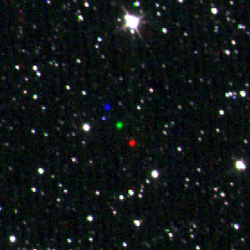 Composite of three images taken by the Cassini spacecraft in 2013, showing Siarnaq's location at ten-minute intervals[lower-alpha 1] | |
| Discovery[1][2] | |
|---|---|
| Discovered by | B. J. Gladman J. J. Kavelaars[lower-alpha 3] |
| Discovery site | Mauna Kea Obs. |
| Discovery date | 23 September 2000 |
| Designations | |
Designation | Saturn XXIX |
| Pronunciation | /ˈsiːɑːrnɑːk/ |
Named after | Siarnaq (Inuit mythology) |
| S/2000 S 3 | |
| Adjectives | Siarnaupian, Siarnaqian[lower-alpha 4] |
| Orbital characteristics[3] | |
| Epoch 27 June 2015 (JD 2457200.5) | |
| Observation arc | 14.75 yr (5,384 days) |
| 0.1199007 AU (17,936,900 km) | |
| Eccentricity | 0.4476265 |
| 2.46 yr (896.88 d) | |
| 315.95128° | |
| Inclination | 46.10229° (to ecliptic) |
| 47.82487° | |
| 71.02528° | |
| Satellite of | Saturn |
| Group | Inuit group |
| Physical characteristics | |
Mean diameter | 39.3±5.9 km[4] |
| 10.18785±0.00005 h[5][6] | |
Pole ecliptic latitude | 98°±15°[6] |
Pole ecliptic longitude | −23°±15°[6] |
| Albedo | 0.050±0.017[4] |
Spectral type | D (reddish)[7] B−V=0.87±0.01[7] V−R=0.48±0.01 V−I=1.03±0.01 |
| 19.9[8] | |
| 10.9±0.05[4] | |
History
Discovery
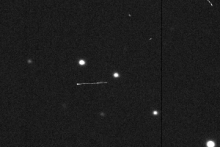

Siarnaq was discovered by Canadian astronomers Brett Gladman and John Kavelaars at the Mauna Kea Observatory on 23 September 2000. The discovery of Siarnaq formed part of an observational campaign, coordinated by Gladman in late 2000, to search for distant irregular satellites around Saturn. The campaign consisted of an international team of eight astronomers[lower-alpha 2] using various ground-based telescopes to survey Saturn's Hill sphere, the region within which satellites can have stable orbits around the planet.[11][12] The first campaign observations were conducted in August 2000 and produced two irregular satellite candidates: Ymir and Paaliaq.[13][14] However, with a limited set of observations, their orbits were indeterminate and required further observations before announcing their discoveries.
On 23 September 2000, a more extensive search for irregular satellites was conducted by Gladman and Kavelaars using the 3.6-meter Canada-France-Hawaii Telescope (CFHT) at the Mauna Kea Observatory in Hawaii. With a wide field of view along with a digital charge-coupled device camera, the CFHT covered a larger search area than the August observations, down to a limiting magnitude of 24.5.[lower-alpha 5][14] Gladman and Kavelaars reobserved the two satellites from August and identified two more new irregular satellite candidates: Siarnaq and Tarvos. Siarnaq, the brighter of the two, was detected at an apparent magnitude of 20.[2] Shortly after the survey, the two candidates were reported to other astronomers for further confirmation.[12][15]
Between 25–29 September 2000, follow-up observations of the four irregular satellites were made at various observatories.[16] Preliminary orbit calculations ruled out the possibility that the satellites could be foreground asteroids, confirming that Ymir, Paaliaq, Siarnaq, and Tarvos were indeed orbiting Saturn.[15] The discovery of the four Saturnian satellites was formally reported by the International Astronomical Union on 25 October 2000,[2][13] and was announced by Gladman's team a day later at a meeting hosted by the American Astronomical Society's Division for Planetary Sciences.[12] The discovery of the four satellites raised Saturn's known moons to 22, surpassing Uranus's moon count of 21 at the time.[15]
Although Siarnaq was confirmed as a satellite, its orbit was poorly determined and required extensive follow-up observations.[17] The moon was reobserved by the Kitt Peak National Observatory in December 2000,[18] and later by the Palomar and La Palma observatories in early 2001.[16] In the interim, Gladman's team had discovered eight more irregular satellites of Saturn, six of which were found in CFHT images from September 2000.[14] By February 2001, the team surveyed 90 percent of Saturn's Hill sphere down to a limiting magnitude of 23 and discovered a total of 12 irregular satellites around Saturn, raising the planet's number of known moons to 30 and overtaking Jupiter as the planet with the most known moons until 2003.[11][19]
Naming
The moon is named after Siarnaq, the Inuit giantess or goddess of the sea who also ruled the Inuit underworld.[20] In other variants of Inuit legend, she is also known by other names such as Nuliajuk and Sedna. Siarnaq resides at the bottom of the ocean and conceived all sea life, which she will withhold from Inuit hunters when angered.[21] In Inuit legend, Siarnaq was once a beautiful maiden who was tricked by a bird-man into marrying him. Her father kills the bird-man and attempts to return her home in his kayak, but the bird-man's cohorts cause a storm in vengeance. In desperation, the father threw his daughter overboard but she continued to cling to the edge of the kayak, so he chopped off her fingers with his knife. As she sank to the bottom of the ocean, all the creatures of the sea flowed out from her fingers and she became the sea goddess.[21]
Upon the announcement of its discovery, the moon was given the provisional designation S/2000 S 3. The provisional designation indicates that it was the third Saturnian satellite identified in images taken in 2000.[2][lower-alpha 6] Siarnaq is among the first Saturnian irregular satellites to be discovered since Phoebe in 1898; the discovery of new satellite groups of Saturn provided the opportunity for their discoverers to establish new naming conventions for each of them.[11][21]
Kavelaars was advised by his colleagues to propose names from different cultures other than those from the traditional Greco-Roman mythology theme for Jovian and Saturnian moons. Throughout late 2000, Kavelaars spent several months trying to find names that were both multicultural and Canadian, consulting Amerindian scholars without finding a name that seemed appropriate. In March 2001, he was reading the Inuit tale Hide and Sneak to his children and had a revelation. He contacted the author of the tale, Michael Kusugak, to get his assent, and the latter suggested the names Kiviuq and Sedna.[22] Kavelaars then decided that the selected Inuit names should end in the letter q to distinguish the group—hence the name Sedna was changed to Siarnaq.[21] The former name was later used for 90377 Sedna, a distant trans-Neptunian object discovered in 2003.[20]
I sent [Kavelaars] that bit about Siarnaq, or we call her Nuliajuk, that creature that lives under the sea, who's also know [sic] as Sedna. She's got so many names ... sometimes she's simply called the Old Woman Who Lives Down There. Anyway, I was talking about the realm of the shaman in this book, and I said, "And the only person who can go down there and comb her hair and make her feel better is the shaman Paaliaq." And this was just something I made up in my story. So I was really surprised when the final approved list of names of these four moons of Saturn included Paaliaq, because I just made him up. That was fun.
— Michael Kusugak, in a Windspeaker interview[21]
The four members of the Inuit group of satellites received the names Paaliaq, Siarnaq, Kiviuq, and Ijiraq. Their names along with eight other Saturnian satellites of the Norse and Gallic group were approved by the IAU's Working Group for Planetary System Nomenclature in a general assembly held in July 2003, and later announced in a formal notice published by the IAU on 8 August 2003.[21] Siarnaq was also assigned the Roman numeral designation Saturn XXIX, the 29th moon of Saturn.[9]
Physical characteristics
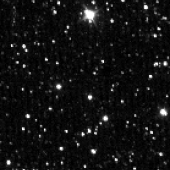
From infrared observations by the Wide-field Infrared Survey Explorer (WISE) spacecraft, Siarnaq is estimated to be 39.3 km (24.4 mi) in diameter.[4] It is light red in color, and the Siarnaupian (Siarnaqan)[lower-alpha 4] spectrum in the infrared is very similar to the Inuit-group satellites Paaliaq and Kiviuq, supporting the thesis of a possible common origin in the break-up of a larger body.[7][14][23]
Shape and rotation
The rotation period of Siarnaq was measured by the Cassini spacecraft to be 10.19 hours; this is the shortest rotation period of all prograde irregular moons of Saturn.[5] Siarnaq displays a light curve with three maxima and minima over a full rotation, implying a roughly triangular shape.[6] From Cassini observations of Siarnaq at different phase angles, the orientation of its north rotational pole has been determined to be pointing toward 98° ecliptic latitude and −23° ecliptic longitude.[lower-alpha 7] This corresponds to a sideways axial tilt, indicating that Siarnaq experiences long, extreme seasons similar to the planet Uranus.[6]
Orbit
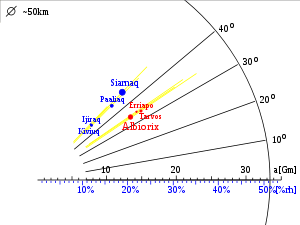
Siarnaq orbits Saturn at an average distance of 17.9 million km (11.1 million mi) in 897 days (2.5 years).[3] The moon has been found to be in a secular resonance with Saturn, involving the precession of its periapsis and that of the planet.[25][lower-alpha 8]
The studies of these resonances are key to understand the capture mechanism for the irregular satellites and, assuming a common origin of a given dynamical group in the break-up of a single body, to explain today's dispersion of the orbital elements.
Notes
- Merger of three images, colored red, green, and blue respectively, to highlight Siarnaq as it moves relative to the background stars.
- Brett J. Gladman, John J. Kavelaars, Jean-Marc Petit, Hans Scholl, Matthew Holman, Brian G. Marsden, Phil Nicholson and Joseph A. Burns.[10]
- The Jet Propulsion Laboratory's Solar System Dynamics page credits the discovery to Gladman and Kavelaars[1] while the International Astronomical Union's Gazetteer of Planetary Nomenclature credits the entire team of astronomers involved in the survey.[lower-alpha 2]
- The genitive form of Siarnaq is Siarnaup. Thus the adjectival form could be absolutive Siarnaqian or genitive Siarnaupian, parallel to nominative Venusian and genitive Venerian for Venus. See Inuktitut morphology
- The August observations covered annular radii of 8′–40′ (arcseconds) from Saturn while the September observations covered annular radii of 12′–60′.[14]
- Gladman's astrometry page for Siarnaq notes that the moon was temporarily given the designation S/2000 S 2 before being renumbered to S 3 in the discovery announcement.[16]
- For geocentric equatorial coordinates, the north pole orientation of Siarnaq is RA = 97°±15°, Dec = 0°±15°.[24]
- The ecliptic longitudes of the periapsis of the satellite and the planet are locked.
References
- "Planetary Satellite Discovery Circumstances". Jet Propulsion Laboratory. 28 October 2019. Retrieved 27 July 2020.
- Marsden, Brian G. (25 October 2000). "IAUC 7513: S/2000 S 3, S/2000 S 4". International Astronomical Union Circular. International Astronomical Union. Bibcode:2000IAUC.7513....1G. Retrieved 27 July 2020.
- "M.P.C. 94683" (PDF). Minor Planet Circular. Minor Planet Center. 2 July 2015. Retrieved 27 July 2020.
- Grav, T.; Bauer, J. M.; Mainzer, A. K.; Masiero, J. R.; Nugent, C. R.; Cutri, R. M.; et al. (August 2015). "NEOWISE: Observations of the Irregular Satellites of Jupiter and Saturn". The Astrophysical Journal. 809 (1): 9. Bibcode:2015ApJ...809....3G. doi:10.1088/0004-637X/809/1/3. 3.
- Denk, Tilmann; Mottola, Stefano (April 2019). Schenk, Paul M.; et al. (eds.). "Studies of irregular satellites: I. Lightcurves and rotation periods of 25 Saturnian moons from Cassini observations". Icarus. 322: 80–102. Bibcode:2019Icar..322...80D. doi:10.1016/j.icarus.2018.12.040.
- Denk, T.; Mottola, S.; Bottke, W. F.; Hamilton, D. P. (2018). "The Irregular Satellites of Saturn". Enceladus and the Icy Moons of Saturn (PDF). 322. University of Arizona Press. pp. 409–434. Bibcode:2018eims.book..409D. doi:10.2458/azu_uapress_9780816537075-ch020. ISBN 9780816537488.
- Grav, Tommy; Bauer, James (November 2007). "A deeper look at the colors of the saturnian irregular satellites". Icarus. 191 (1): 267–285. arXiv:astro-ph/0611590. Bibcode:2007Icar..191..267G. doi:10.1016/j.icarus.2007.04.020.
- "Planetary Satellite Physical Parameters". Jet Propulsion Laboratory. 19 February 2015. Retrieved 27 July 2020.
- Green, Daniel W. E. (8 August 2003). "IAUC 8177: Sats OF (22); Sats OF JUPITER, SATURN, URANUS". International Astronomical Union Circular. International Astronomical Union. Bibcode:2000IAUC.7513....1G. Retrieved 27 July 2020.
- "Planet and Satellite Names and Discoverers". Gazetteer of Planetary Nomenclature. USGS Astrogeology Science Center. Retrieved 30 July 2020.
- "The Irregular Satellites: Chips Off Older Blocks". Observatoire de la Cote d'Azur. 12 July 2001. Archived from the original on 21 November 2001. Retrieved 31 July 2020.
- Brand, David (26 October 2000). "Satellite-hunters find four new moons of the planet Saturn". Cornell Chronicle. Cornell University. Archived from the original on 11 December 2000. Retrieved 29 July 2020.
- Marsden, Brian G. (25 October 2000). "IAUC 7512: S/2000 S 1, S/2000 S 2". International Astronomical Union Circular. International Astronomical Union. Bibcode:2000IAUC.7512....1G. Retrieved 27 July 2020.
- Gladman, Brett; Kavelaars, J. J.; Holman, Matthew; Nicholson, Philip D.; Burns, Joseph A.; Hergenrother, Carl W.; et al. (July 2001). "Discovery of 12 satellites of Saturn exhibiting orbital clustering". Nature. 412 (6843): 163–166. Bibcode:2001Natur.412..163G. doi:10.1038/35084032. PMID 11449267.
- "Saturn Swarming with Satellites". Observatoire de la Cote d'Azur. 26 October 2000. Archived from the original on 9 December 2000. Retrieved 29 July 2020.
- Gladman, Brett J. (January 2003). "Known astrometry of S/2000 S 3". Observatoire de la Cote d'Azur. Retrieved 2 August 2020.
- Marsden, Brian G. (18 November 2000). "IAUC 7521: S/2000 S 5, S/2000 S 6". International Astronomical Union Circular. International Astronomical Union. Bibcode:2000IAUC.7521....1G. Retrieved 2 August 2020.
- Marsden, Brian G. (19 December 2000). "MPEC 2000-Y14 : S/2000 S 3, S/2000 S 4, S/2000 S 5, S/2000 S 6, S/2000 S 10". Minor Planet Electronic Circular. Minor Planet Center.
- Hamilton, Douglas P. (12 July 2001). "Saturn saturated with satellites". Nature. 412 (6843): 132–133. Bibcode:2001Natur.412..132H. doi:10.1038/35084310. Retrieved 31 July 2020.
- "Siarnaq In Depth". Solar System Exploration. NASA. 19 December 2019. Retrieved 5 August 2020.
- Petten, Cheryl (2003). "Naming Saturn's moons". Windspeaker. 21 (7). Aboriginal Multi-Media Society. p. 32. Retrieved 2 August 2020.
- Spitzer, Aaron (27 July 2001). "Inuktitut travels to the planets". Nunatsiaq News. Retrieved 5 August 2020.
- Grav, Tommy; Holman, Matthew J.; Gladman, Brett J.; Asknes, Kaare (November 2003). "Photometric survey of the irregular satellites". Icarus. 166 (1): 33–45. arXiv:astro-ph/0301016. Bibcode:2003Icar..166...33G. doi:10.1016/j.icarus.2003.07.005.
- Denk, Tilmann (19 October 2019). "Siarnaq (S/2000 S 3)". Tilmann's Web Site. Retrieved 27 July 2020.
- Ćuk, Matija; Burns, Joseph A. (November 2004). "On the Secular Behavior of Irregular Satellites". The Astronomical Journal. 128 (5): 2518–2541. arXiv:astro-ph/0408119. Bibcode:2004AJ....128.2518C. doi:10.1086/424937.
External links
| Wikimedia Commons has media related to Siarnaq (moon). |
- Natural Satellites Ephemeris Service, Minor Planet Center
- Siarnaq In Depth, NASA Solar System Exploration, updated 19 December 2019
- Siarnaq (S/2000 S 3), Tilmann Denk, updated 19 October 2019
- Four more moons for Saturn, David Adam, Nature, 26 October 2000
- New moons: not standing alone, David Adam, Nature, 26 October 2000
- The Irregular Satellites of Saturn, Brett Gladman, Observatoire de la Cote d'Azur, October 2000
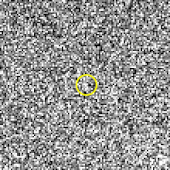
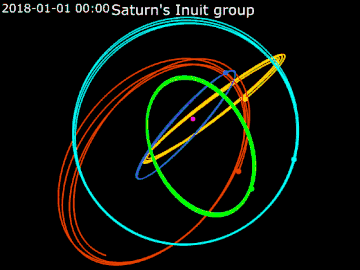
.jpg)